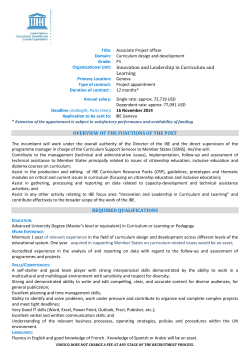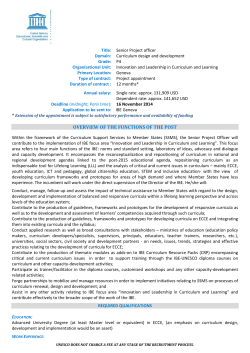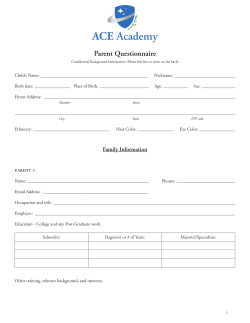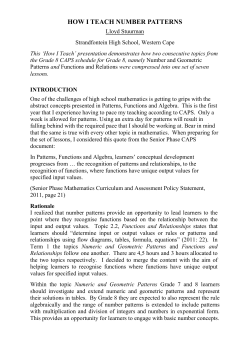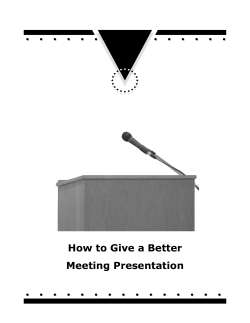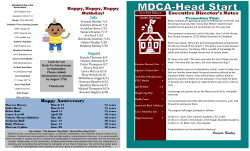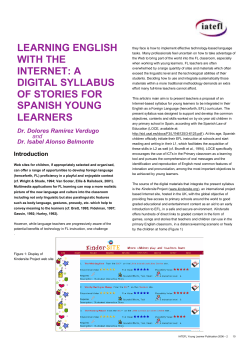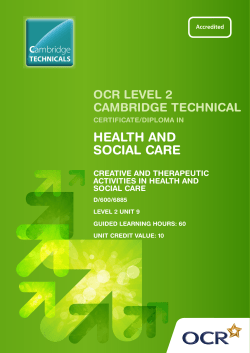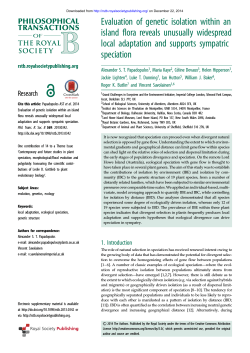
How children learn CTICES SERIES–7
INTERNATIONAL BUREAU OF EDUCATION How children learn By Stella Vosniadou EDUCATIONAL PRACTICES SERIES–7 INTERNATIONAL ACADEMY OF EDUCATION The International Academy of Education The International Academy of Education (IAE) is a not-forprofit scientific association that promotes educational research, its dissemination, and the implementation of its implications. Founded in 1986, the Academy is dedicated to strengthening the contributions of research, solving critical educational problems throughout the world, and providing better communication among policy makers, researchers and practitioners. The seat of the Academy is at the Royal Academy of Science, Literature and Arts in Brussels, Belgium, and its co-ordinating centre is at Curtin University of Technology in Perth, Australia. The general aim of the IAE is to foster scholarly excellence in all fields of education. Towards this end, the Academy provides timely syntheses of research-based evidence of international importance. The Academy also provides critiques of research, its evidentiary basis, and its application to policy. The current members of the Board of Directors of the Academy are: • Erik De Corte, University of Leuven, Belgium (President) • Herbert Walberg, University of Illinois at Chicago, United States of America (Vice President) • Barry Fraser, Curtin University of Technology, Australia (Executive Director) • Jacques Hallak, Paris, France • Michael Kirst, Stanford University, United States of America • Ulrich Teichler, University of Kassel, Germany • Margaret Wang, Temple University, United States of America http://www.curtin.edu.au/curtin/dept/smec/iae 2 Preface This booklet is about how children learn. It has been prepared for inclusion in the Educational Practices Series developed by the International Academy of Education and distributed by the International Bureau of Education and the Academy. As part of its mission, the Academy provides timely syntheses of research on educational topics of international importance. This booklet is the seventh in the series on educational practices that generally improve learning. The author is Stella Vosniadou, who has written many articles and books in the area of cognitive, developmental and educational psychology. She has taught at the University of Illinois in Urbana-Champaign and at the University of Athens, and was president of the European Association for Research on Learning and Instruction. She is currently the director of a graduate programme in cognitive science in the Department of Philosophy and History of Science at the University of Athens. The officers of the International Academy of Education are aware that this booklet is based on research carried out primarily in economically advanced countries. The booklet, however, focuses on aspects of how children learn that appear to be universal in much formal and informal schooling. The practices presented here are likely to be generally applicable throughout the world. Even so, the principles should be assessed with reference to local conditions, and adapted accordingly. In any educational setting or cultural context, suggestions or guidelines for practice require sensitive and sensible application, and continuing evaluation. HERBERT J. WALBERG Editor, IAE Educational Practices Series University of Illinois at Chicago 3 Previous titles in the ‘Educational practices series’ 1. Teaching by Jere Brophy. 36 p. 2. Parents and learning by Sam Redding. 36 p. 3. Effective educational practices by Herbert J. Walberg and Susan J. Paik. 24 p. 4. Improving student achievement in mathematics by Douglas A. Grouws and Kristin J. Cebulla. 48 p. 5. Tutoring by Keith Topping. 36 p. 6. Teaching additional languages by Elliot L. Judd, Lihua Tan and Herbert J. Walberg. 28 p. These titles can be downloaded from the websites of the IEA (http://www.curtin.edu.au/curtin/dept/smec/iae) or of the IBE (http://www.ibe.unesco.org/publications) or paper copies can be requested from: IBE, Publications Unit, P.O. Box 199, 1211 Geneva 20, Switzerland. 4 Table of contents Introduction, page 6 1. Active involvement, page 8 2. Social participation, page 9 3. Meaningful activities, page 11 4. Relating new information to prior knowledge, page 12 5. Being strategic, page 14 6. Engaging in self-regulation and being reflective, page 16 7. Restructuring prior knowledge, page 18 8. Aiming towards understanding rather than memorization, page 20 9. Helping students learn to transfer, page 22 10. Taking time to practice, page 23 11. Developmental and individual differences, page 25 12. Creating motivated learners, page 27 References and further reading, page 29 This publication has been produced in 2001 by the International Academy of Education (IAE), Palais des Académies, 1, rue Ducale, 1000 Brussels, Belgium, and the International Bureau of Education (IBE), P.O. Box 199, 1211 Geneva 20, Switzerland. It is available free of charge and may be freely reproduced and translated into other languages. Please send a copy of any publication that reproduces this text in whole or in part to the IAE and the IBE. This publication is also available on the Internet. See the ‘Publications’ section, ‘Educational Practices Series’ page at: http://www.ibe.unesco.org The author is responsible for the choice and presentation of the facts contained in this publication and for the opinions expressed therein, which are not necessarily those of UNESCO/IBE and do not commit the organization. The designations employed and the presentation of the material in this publication do not imply the expression of any opinion whatsoever on the part of UNESCO/IBE concerning the legal status of any country, territory, city or area, or of its authorities, or concerning the delimitation of its frontiers or boundaries. Printed in France by SADAG, Bellegarde. 5 Introduction The psychological principles described in this booklet summarize some of the important results of recent research on learning that is relevant for education. They attempt to integrate research coming from diverse areas of psychology, including educational, developmental, cognitive, social and clinical psychology. This research has offered us new insights into the learning process and the development of knowledge in many subject-matter areas. As a result, curricula and instruction are changing in schools today. They are attempting to become more studentcentred than teacher-centred, to connect the school to real-life situations, and to focus on understanding and thinking rather than on memorization, drill and practice. Although each principle is explained on its own, all twelve principles are best understood as an organized whole with one supporting the others. As a whole, these principles are meant to provide a comprehensive framework for the design of curricula and of instruction. Indeed, they are found behind a number of innovative programmes in schools across the world today. We begin with a discussion of three principles that are widely recognized as forming the basis on which teachers should design the learning environments of today’s schools; namely, learning environments that encourage students to be active learners, to collaborate with other students, and to use meaningful tasks and authentic materials. We continue with seven principles that focus on cognitive factors that are primarily internal, but also interact with environmental factors in important ways. Teachers need to take these principles into consideration in order to design more effective curricula and instruction. We end with a discussion of developmental and individual differences, and with motivational influences on learning. These last two areas are very important for learning and instruction, and—to be treated adequately—deserve to become independent booklets. We have not dealt with a subject that is becoming very important in the schools of today—the use of information and communication technology to support learning. We have not done so because this area is too vast and we believe that a special booklet needs to be devoted to it. 6 In discussing each principle, we start by presenting a summary of the research findings and then continue describing the implications for teaching that follow from them. At the end of the booklet there is a list of references and suggested readings that provide further information on the principles that have been discussed. 7 1. Active involvement Learning requires the active, constructive involvement of the learner. Research findings Learning at school requires students to pay attention, to observe, to memorize, to understand, to set goals and to assume responsibility for their own learning. These cognitive activities are not possible without the active involvement and engagement of the learner. Teachers must help students to become active and goaloriented by building on their natural desire to explore, to understand new things and to master them. In the classroom It is a challenge for teachers to create interesting and challenging learning environments that encourage the active involvement of students. The following are some suggestions as to how this can be done: • Avoid situations where the students are passive listeners for long periods of time. • Provide students with hands-on activities, such as experiments, observations, projects, etc. • Encourage participation in classroom discussions and other collaborative activities. • Organize school visits to museums and technological parks. • Allow students to take some control over their own learning. Taking control over one’s learning means allowing students to make some decisions about what to learn and how. • Assist students in creating learning goals that are consistent with their interests and future aspirations. References: Elmore, Peterson & McCarthy, 1996; Piaget, 1978; Scardamalia & Bereiter, 1991. 8 2. Social participation Learning is primarily a social activity and participation in the social life of the school is central for learning to occur. Research findings For many researchers, social participation is the main activity through which learning occurs. Social activity and participation begin early on. Parents interact with their children and through these interactions children acquire the behaviours that enable them to become effective members of society. According to the psychologist Lev Vygotsky, the way children learn is by internalizing the activities, habits, vocabulary and ideas of the members of the community in which they grow up. The establishment of a fruitful collaborative and co-operative atmosphere is an essential part of school learning. Research has shown that social collaboration can boost student achievement, provided that the kinds of interactions that are encouraged contribute to learning. Finally, social activities are interesting in their own right and help to keep students involved in their academic work. Students work harder to improve the quality of their products (essays, projects, artwork, etc.) when they know that they will be shared with other students. In the classroom Teachers can do many things to encourage social participation in ways that facilitate learning: • They can assign students to work in groups and assume the role of a coach/co-ordinator who provides guidance and support to the groups. • They can create a classroom environment that includes group workspaces where resources are shared. • Through modelling and coaching, they can teach students how to co-operate with each other. 9 • They can create circumstances for students to interact with each other, to express their opinions and to evaluate other students’ arguments. • An important aspect of social learning is to link the school to the community at large. In this way, students’ opportunities for social participation are enlarged. References: Brown et al., 1996; Collins, Brown & Newman, 1989; Rogoff, 1990; Vygotsky, 1978. 10 3. Meaningful activities People learn best when they participate in activities that are perceived to be useful in real life and are culturally relevant. Research findings Many school activities are not meaningful since students understand neither why they are doing them nor what their purpose and usefulness is. Sometimes school activities are not meaningful because they are not culturally appropriate. Many schools are communities where children from diverse cultures learn together. There are systematic cultural differences in practices, in habits, in social roles, etc., that influence learning. Sometimes meaningful activities for students coming from one cultural group are not meaningful to students who are coming from another cultural group. In the classroom Teachers can make classroom activities more meaningful by situating them in an authentic context. An example of an authentic context is one in which the activity is typically used in real life. For example, students can improve their oral language and communication skills by participating in debates. They can improve their writing skills by being involved in the preparation of a classroom newspaper. Students can learn science by participating in a community or school environmental project. The school can be in contact with local scientists and invite them to lecture, or allow the students to visit their laboratories. It is also important for teachers to be aware of the cultural differences of the children in their classroom and to respect these differences. They must see them as strengths to build on, rather than as defects. Children will feel differently in the classroom if their culture is reflected in the common activities. School routines that are unfamiliar to some children can be introduced gradually so that the transition can be less traumatic for ethnically diverse groups. References: Brown, Collins & Duguid, 1989; Heath, 1983. 11 4. Relating new information to prior knowledge New knowledge is constructed on the basis of what is already understood and believed. Research findings The idea that people’s ability to learn something new follows from what they already know is not new, but more recent research findings have shown that the ability to relate new information to prior knowledge is critical for learning. It is not possible for someone to understand, remember or learn something that is completely unfamiliar. Some prior knowledge is necessary to understand the task at hand. But having the prerequisite prior knowledge is still not sufficient to ensure adequate results. People must activate their prior knowledge in order to be able to use it for understanding and for learning. Research shows that students do not consistently see the relationships between new material that they read and what they already know. Research also shows that learning is enhanced when teachers pay close attention to the prior knowledge of the learner and use this knowledge as the starting point for instruction. In the classroom Teachers can help students activate prior knowledge and use it for the task at hand. This can be done in a number of ways. • Teachers can discuss the content of a lesson before starting in order to ensure that the students have the necessary prior knowledge and in order to activate this knowledge. • Often students’ prior knowledge is incomplete or there are false beliefs and critical misconceptions. Teachers do not simply need to know that students know something about the topic to be introduced. They need to investigate students’ prior knowledge in detail so that false beliefs and misconceptions can be identified. • Teachers may need to go back to cover important prerequisite material or ask the students to do some preparatory work on their own. 12 • Teachers can ask the kind of question that helps students see relationships between what they are reading and what they already know. • Effective teachers can help students to grasp relationships and make connections. They can do so by providing a model or a scaffold that students can use as support in their efforts to improve their performance. References: Bransford, 1979; Bransford, Brown & Cocking, 1999. 13 5. Being strategic People learn by employing effective and flexible strategies that help them to understand, reason, memorize and solve problems. Research findings Children develop strategies to help themselves solve problems from an early age. For example, when pre-school children are told to go to the supermarket to buy a list of food items, they often repeat the items on their way to remember them better. These children have discovered rehearsal as a strategy to improve their memory without anybody telling them to do so. When they go to school, children need help from teachers to develop appropriate strategies for solving mathematics problems, when understanding texts, doing science, learning from other students, etc. Research shows that when teachers make systematic attempts to teach learning strategies to students substantial gains can result. Strategies are important because they help students understand and solve problems in ways that are appropriate for the situation at hand. Strategies can improve learning and make it faster. Strategies may differ in their accuracy, in their difficulty of execution, in their processing demands and in the range of problems to which they apply. The broader the range of strategies that children can use appropriately, the more successful they can be in problem solving, in reading, in text comprehension and in memorizing. In the classroom Teachers must recognize the importance of students knowing and using a variety of strategies. The teaching of strategies can be done directly or indirectly. In the latter case, the teacher can give students a task and provide a model of the inquiry process or ask key questions. For example, in reading, teachers can explicitly show students how to outline the important points in a text and how to summarize them. Alternatively, they can ask 14 a group of students to discuss a text and summarize it. They can help in this process by participating in the discussion and by asking critical questions. In science, teachers can show students how to conduct experiments: how to form hypotheses, how to keep a systematic record of their findings, and how to evaluate them. It is important to ensure that students learn to use these strategies on their own and do not always rely on teachers to provide the necessary support. Teachers need to gradually fade their assistance and allow students to take greater responsibility for their learning. References: Mayer, 1987; Palincsar & Brown, 1984; White & Frederickson, 1998. 15 6. Engaging in self-regulation and being reflective Learners must know how to plan and monitor their learning, how to set their own learning goals and how to correct errors. Research findings The term ‘self-regulation’ is used here to indicate students’ ability to monitor their own learning, to understand when they are making errors, and to know how to correct them. Selfregulation is not the same as being strategic. People can use strategies for learning mechanically without being fully aware of what they are doing. Self-regulation involves the development of specific strategies that help learners evaluate their learning, check their understanding and correct errors when appropriate. Self-regulation requires reflection in the sense of being aware of one’s own beliefs and strategies. Reflection can develop through discussion, debates and essays, where children are encouraged to express their opinions and defend them. Another important aspect of reflection is being able to distinguish appearance from reality, common beliefs from scientific knowledge, etc. In the classroom Teachers can help students become self-regulated and reflective by providing opportunities: • To plan how to solve problems, design experiments and read books; • To evaluate the statements, arguments, solutions to problems of others, as well as of one’s self; • To check their thinking and ask themselves questions about their understanding— (Why am I doing what I am doing? How well am I doing? What remains to be done?); 16 • To develop realistic knowledge of themselves as learners— (I am good in reading, but need to work on my mathematics); • To set their own learning goals; • To know what are the most effective strategies to use and when to use them. References: Brown, 1975; Boekaerts, Pintrich & Zeidner, 2000; Marton & Booth, 1997. 17 7. Restructuring prior knowledge Sometimes prior knowledge can stand in the way of learning something new. Students must learn how to solve internal inconsistencies and restructure existing conceptions when necessary. Research findings Sometimes existing knowledge can stand in the way of understanding new information. While this is often the case in the learning of science and mathematics, it can apply to all subjectmatter areas. It happens because our current understanding of the physical and social world, of history, of theorizing about numbers, etc., is the product of thousands of years of cultural activity that has radically changed intuitive ways of explaining phenomena. For example, in the area of mathematics, many children make mistakes when they use fractions because they use rules that apply to natural numbers only. Similarly, in the physical sciences, students form various misconceptions. The idea that the Earth is round like a pancake or like a sphere flattened on the top happens because it reconciles the scientific information that the Earth is round, with the intuitive belief that it is flat and that people live upon its top. Such misconceptions do not apply only in young children. They are common in high school and college students as well. In the classroom What can teachers do to facilitate the understanding of counterintuitive information? • Teachers need to be aware that students have prior beliefs and incomplete understandings that can conflict with what is being taught at school. • It is important to create the circumstances where alternative beliefs and explanations can be externalized and expressed. 18 • Teachers need to build on the existing ideas of students and slowly lead them to more mature understandings. Ignoring prior beliefs can lead to the formation of misconceptions. • Students must be provided with observations and experiments that have the potential of showing to them that some of their beliefs can be wrong. Examples from the history of science can be used for this purpose. • Scientific explanations must be presented with clarity and, when possible, exemplified with models. • Students must be given enough time to restructure their prior conceptions. In order to do this, it is better to design curricula that deal with fewer topics in greater depth than attempting to cover a great deal of topics in a superficial manner. References: Carretero & Voss, 1994; Driver, Guesne & Tiberghien, 1985; Schnotz, Vosniadou & Carretero, 1999; Vosniadou & Brewer, 1992. 19 8. Aiming towards understanding rather than memorization Learning is better when material is organized around general principles and explanations, rather than when it is based on the memorization of isolated facts and procedures. Research findings All teachers want their students to understand what they are learning and not to memorize facts in a superficial way. Research shows that when information is superficially memorized it is easily forgotten. On the contrary, when something is understood, it is not forgotten easily and it can be transferred to other situations (see also the next principle on transfer). In order to understand what they are being taught, students must be given the opportunity to think about what they are doing, to talk about it with other students and with teachers, to clarify it and to understand how it applies in many situations. In the classroom How does one teach for understanding? The following are some tasks teachers can carry out in order to promote understanding of the material that has been taught: • Ask students to explain a phenomenon or a concept in their own words. • Show students how to provide examples that illustrate how a principle applies or how a law works. • Students must be able to solve characteristic problems in the subject-matter area. Problems can increase in difficulty as students acquire greater expertise. • When students understand the material, they can see similarities and differences, they can compare and contrast, and they can understand and generate analogies. 20 • Teach students how to abstract general principles from specific cases and generalize from specific examples. References: Halpern, 1992; Resnick & Klopfer, 1989; Perkins, 1992. 21 9. Helping students learn to transfer Learning becomes more meaningful when the lessons are applied to real-life situations. Research findings Students often cannot apply what they have learned at school to solve real-world problems. For example, they may learn about Newton’s laws at school but fail to see how they apply in reallife situations. Transfer is very important. Why should someone want to go to school if what is learned there does not transfer to other situations and cannot be used outside the school? In the classroom Teachers can improve students’ ability to transfer what they have learned at school by: • Insisting on mastery of subject matter. Without an adequate degree of understanding, transfer cannot take place (see previous principle). • Helping students see the transfer implications of the information they have learned. • Applying what has been learned in one subject-matter area to other areas to which it may be related. • Showing students how to abstract general principles from concrete examples. • Helping students learn how to monitor their learning and how to seek and use feedback about their progress. • Teach for understanding rather than for memorization (see previous principle). References: Bruer, 1993; Bransford, Brown & Cocking, 1999; Bereiter, 1997. 22 10. Taking time to practice Learning is a complex cognitive activity that cannot be rushed. It requires considerable time and periods of practice to start building expertise in an area. Research findings Research shows that people must carry out a great deal of practice to acquire expertise in an area. Even small differences in the amount of time during which people are exposed to information can result in large differences in the information they have acquired. Cognitive psychologists Chase & Simon (1973) studied chess experts and found that they had often spent as many as 50,000 hours practising chess. A 35-year-old chess master who has spent 50,000 hours playing chess must have spent four to five hours on the chessboard from the age of 5 every day for thirty years! Less accomplished players have spent considerably less time playing chess. Research shows that the reading and writing skills of highschool students relate to the hours they have spent on reading and writing. Effective reading and writing requires a lot of practice. Students from disadvantaged environments who have less opportunities to learn and who miss school because of work or illness will not be expected to do as well at school compared to children who had more time to practice and acquire information. In the classroom Many educational programmes are designed to increase one’s exposure to learning situations preferably at an early age. Here are some recommendations for teachers that can help students spend more time on learning tasks. • Increase the amount of time students spend on learning in the classroom. • Give students learning tasks that are consistent with what they already know. • Do not try to cover too many topics at once. Give students time to understand the new information. 23 • Help students engage in ‘deliberate practice’ that includes active thinking and monitoring of their own learning (see sections on self-regulation). • Give students access to books so that they can practice reading at home. • Be in contact with parents so that they can learn to provide richer educational experiences for their children. References: Bransford, 1979; Chase & Simon, 1973; Coles, 1970. 24 11. Developmental and individual differences Children learn best when their individual differences are taken into consideration. Research findings Research shows that there are major developmental differences in learning. As children develop, they form new ways of representing the world and they also change the processes and strategies they use to manipulate these representations. In addition, there are important individual differences in learning. Developmental psychologist Howard Gardner has argued that there are many dimensions of human intelligence other than the logical and linguistic skills that are usually valued in most school environments. Some children are gifted in music, others have exceptional spatial skills (required, for example, by architects and artists), or bodily/kinaesthetic abilities (required by athletes), or abilities to relate to other people, etc. Schools must create the best environment for the development of children taking into consideration such individual differences. In the classroom The following are recommendations for creating the best environment for the development of children, while recognizing their individual differences: • Learn how to assess children’s knowledge, strategies and modes of learning adequately. • Introduce children to a wide range of materials, activities and learning tasks that include language, mathematics, natural sciences, social sciences, art, music, movement, social understanding, etc. • Identify students’ areas of strength, paying particular attention to the interest, persistence and confidence they demonstrate in different kinds of activities. • Support students’ areas of strength and utilize these areas to improve overall academic performance. 25 • Guide and challenge students’ thinking and learning. • Ask children thought-provoking questions and give them problems to solve. Urge children to test hypotheses in a variety of ways. • Create connections to the real world by introducing problems and materials drawn from everyday situations. • Show children how they can use their unique profiles of intelligence to solve real-world problems. • Create circumstances for students to interact with people in the community, and particularly with adults who are knowledgeable and enthusiastic about the kinds of things that are of interest to the students. References: Case, 1978; Chen et al., 1998; Gardner, 1991; Gardner, 1993. 26 12. Creating motivated learners Learning is critically influenced by learner motivation. Teachers can help students become more motivated learners by their behaviour and the statements they make. Research findings Motivated learners are easy to recognize because they have a passion for achieving their goals and are ready to expend a great deal of effort. They also show considerable determination and persistence. This influences the amount and quality of what is learned. All teachers want to have motivated learners in their classrooms. How can they achieve this? Psychologists distinguish between two kinds of motivation: extrinsic motivation and intrinsic motivation. Extrinsic motivation results when positive rewards are used to increase the frequency of a target behaviour. Praise, high grades, awards, money and food can be used for that effect. Intrinsic motivation is when learners actively participate in activities without having to be rewarded for it. The child who likes to put together puzzles for the fun of it is intrinsically motivated. An important characteristic of intrinsically motivated learners is their belief that effort is important for success. Teachers can influence students’ determination to achieve by their behaviour and the statements they make. In the classroom Teachers must use encouraging statements that reflect an honest evaluation of learner performance: • Recognize student accomplishments. • Attribute student achievement to internal and not external factors (e.g. ‘You have good ideas’). • Help students believe in themselves (e.g. ‘You are putting a lot of effort on math and your grades have much improved’). 27 • Provide feedback to children about the strategies they use and instruction as to how to improve them. • Help learners set realistic goals. It is also important to: • Refrain from grouping students according to their ability. Ability grouping gives the message that ability is valued more than effort. • Promote co-operation rather than competition. Research suggests that competitive arrangements that encourage students to work alone to achieve high grades and rewards tend to give the message that what is valued is ability and diminish intrinsic motivation. • Provide novel and interesting tasks that challenge learners’ curiosity and higher-order thinking skills at the appropriate level of difficulty. References: Deci & Ryan, 1985; Dweck, 1989; Lepper & Hodell, 1989; Spaulding, 1992. 28 References and further reading Bereiter, C. 1997. Situated cognition and how to overcome it. In: Kirshner, D.; Whitson, J.A., eds. Situated cognition: social, semiotic, and psychological perspectives, p. 281–300. Hillsdale, NJ, Erlbaum. Boekaerts, M.; Pintrich, P.; Zeidner, M. 2000. Handbook of self-regulation. New York, Academic Press. Bransford, J.D. 1979. Human cognition: learning, understanding and remembering. Belmont, CA, Wadsworth Publishing Co. Bransford, T.D.; Brown, A.L.; Cocking, R.R., eds. 1999. How people learn: brain, mind, experience and school. Washington, DC, National Academy Press. Brown, A.L. 1975. The development of memory: knowing, knowing about knowing and knowing how to know. In: Reese, H.W., ed. Advances in child development and behavior. Vol. 10. New York, Academic Press. Brown, A.L., et al. 1996. Distributed expertise in the classroom. In: Salomon, G., ed. Distributed cognitions: psychological and educational considerations, p. 188–228. Hillsdale, NJ, Erlbaum. Brown, J.S.; Collins, A.; Duguid, P. 1989. Situated cognition and the culture of learning. Educational researcher (Washington, DC), vol. 18, no. 1. Bruer, J.T. 1993. Schools for thought. Cambridge, MA, MIT Press. Carretero M.; Voss, J., eds. 1994. Cognitive and instructional processes in history and the social sciences. Hillsdale, NJ, Erlbaum. Case, R. 1978. Implications of developmental psychology for the design of effective instruction. In: Lesgold, A.M., et al., eds. Cognitive psychology and instruction, p. 441–63. New York, Plenum. Chase, W.G.; Simon, H.A. 1973. The mind’s eye in chess. In: Chase, W.G., ed. Visual information processing. New York, Academic Press. Chen, J., et al. 1998. Building on children’s strengths: the experience of Project Spectrum. New York, Teachers College, Columbia University. Coles, R. 1970. Uprooted children: the early life of migrant farm workers. New York, Harper & Row. Collins, A.; Brown, J.S.; Newman, S.F. 1989. Cognitive apprenticeship: teaching the craft of reading, writing and mathematics. In: Resnick, L.B., ed. Knowing, learning and instruction: essays in honor of Robert Glaser, p. 453–84. Hillsdale, NJ, Lawrence Erlbaum. Deci, E.L.; Ryan, R. 1985. Intrinsic motivation and self-determination in human behaviour. New York, Plenum Press. Driver, R.; Guesne, E.; Tiberghien, A., eds. 1985. Children’s ideas in science. Milton Keynes, United Kingdom, Open University Press. Dweck, C.S. 1989. Motivation. In: Lesgold A.; Glaser, R., eds. Foundations for a psychology of education, p. 87–136. Hillsdale, NJ, Erlbaum. Elmore, R.F.; Peterson, P.L.; McCarthy, S.J. 1996. Restructuring in the classroom: teaching, learning and school organization. San Francisco, CA, Jossey-Bass. 29 Gardner, H. 1991. The unschooled mind: how children think and how schools should teach. New York, Basic Books. ——. 1993. Multiple intelligences: the theory in practice. New York, Basic Books. Halpern, D.F., ed. 1992. Enhancing thinking skills in the sciences and mathematics. Hillsdale, NJ, Erlbaum. Heath, S.B. 1983. Ways with words: language, life and work in communities and classrooms. Cambridge, United Kingdom, Cambridge University Press. Lepper, M.; Hodell, M. 1989. Intrinsic motivation in the classroom. In: Ames, C.; Ames, R., eds. Research on motivation in education, Vol. 3, p. 73-105. New York, Academic Press. Marton, F.; Booth, S. 1997. Learning and awareness. Hillsdale, NJ, Erlbaum. Mayer, R.E. 1987. Educational psychology: a cognitive approach. Boston, MA, Little, Brown. Palincsar, A.S.; Brown, A.L. 1984. Reciprocal teaching of comprehension monitoring activities. Cognition and instruction (Hillsdale, NJ), vol. 1, p. 117–75. Perkins, D. 1992. Smart schools: better thinking and learning for every child. Riverside, NJ, The Free Press. Piaget, J. 1978. Success and understanding. Cambridge, MA, Harvard University Press. Resnick, L.B.; Klopfer, L.E., eds. 1989. Toward the thinking curriculum: current cognitive research. Alexandria, VA, ASCD Books. Rogoff, B. 1990. Apprenticeships in thinking: cognitive development in social context. New York, Oxford University Press. Scardamalia, M.; Bereiter, C. 1991. Higher levels of agency for children in knowledge building: a challenge for the design of new knowledge media. Journal of the learning sciences (Hillsdale, NJ), no. 1, p. 37–68. Schnotz, W.; Vosniadou, S.; Carretero, M. 1999. New perspectives on conceptual change. Oxford, United Kingdom, Elsevier Science. Spaulding, C.L. 1992. Motivation in the classroom. New York, McGraw Hill. Vosniadou, S.; Brewer, W.F. 1992. Mental models of the earth: a study of conceptual change in childhood. Cognitive psychology (San Diego, CA), no. 24, p. 535–58. Vygotsky, L.S. 1978. Mind in society: the development of higher psychological processes. Cambridge, MA, Harvard University Press. White, B.Y.; Frederickson, J.R. 1998. Inquiry, modelling and metacognition: making science accessible to all students. Cognition and instruction (Hillsdale, NJ), vol. 16, no. 1, p. 13–117. 30 NOTES 31 EDUCATIONAL PRACTICES SERIES–7 The International Bureau of Education—IBE An international centre for the content of education, the IBE was founded in Geneva in 1925 as a private institution. In 1929, it became the first intergovernmental organization in the field of education. In 1969, the IBE joined UNESCO as an integral, yet autonomous, institution. It has three main lines of action: (a) organizing the sessions of the International Conference on Education; (b) collecting, analysing and disseminating educational documentation and information, in particular on innovations concerning curricula and teaching methods; and (c) undertaking surveys and studies in the field of comparative education. At the present time, the IBE: (a) manages World data on education, a databank presenting on a comparative basis the profiles of national education systems; (b) organizes regional courses on curriculum development; (c) collects and disseminates through its databank INNODATA notable innovations on education; (d) co-ordinates preparation of national reports on the development of education; (e) administers the Comenius Medal awarded to outstanding teachers and educational researchers; and (f) publishes a quarterly review of education—Prospects, a quarterly newsletter—Educational innovation and information, as well as other publications. In the context of its training courses on curriculum development, the Bureau is establishing regional and sub-regional networks on the management of curriculum change and developing a new information service—a platform for the exchange of information on content. The IBE is governed by a Council composed of representatives of twenty-eight Member States elected by the General Conference of UNESCO. The IBE is proud to be associated with the work of the International Academy of Education and publishes this material in its capacity as a clearinghouse promoting the exchange of information on educational practices. http://www.ibe.unesco.org
© Copyright 2025
